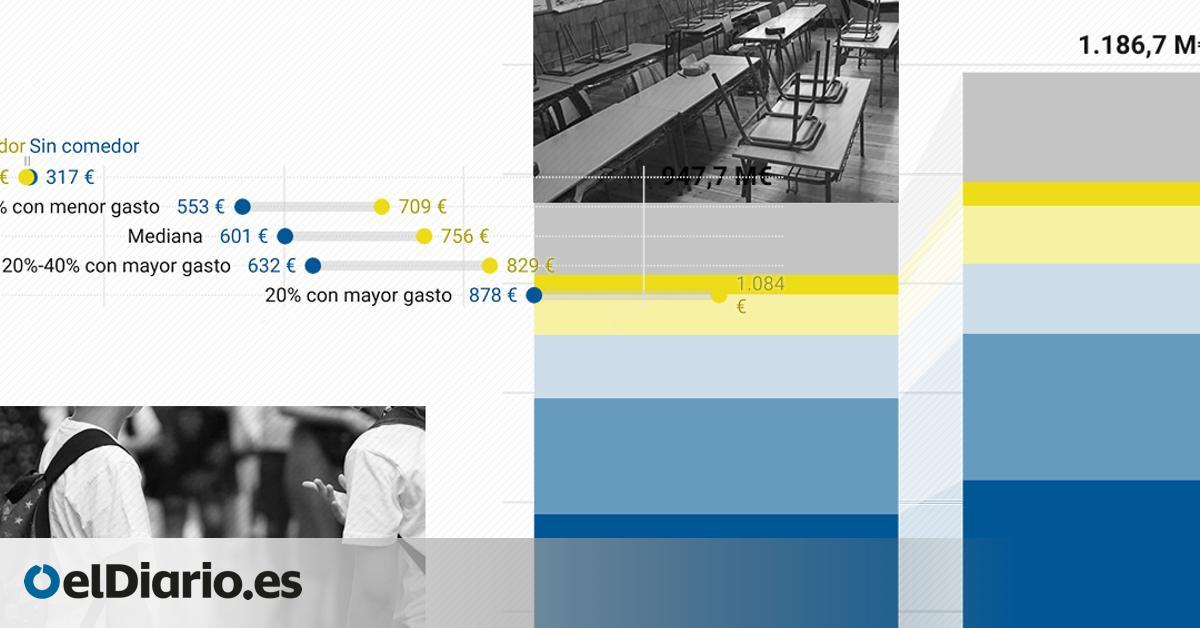
Families who go to charter schools pay between 947 and 1,186 million euros per year to their schools in installments. On average, these families pay 680 to 860 euros per course (depending on the definition of the fee chosen, for example whether it includes the dining room or not), according to the report The cost of access to charter schools in Spain: quantifying the fees and identifying their causesprepared by EsadeEcPol and in which the ecosystem of subsidized centers, families and fees throughout Spain is comprehensively addressed for the first time using data from two different INE surveys.
These figures hide important nuances, according to the study’s authors, in a market that is anything but monolithic. The first is that not all students in private centers supported by public funds pay a monthly fee, although almost all do: between 81% and 95% do, depending on the educational stage.
Other detail The thing is that not all schools have the same motivation when it comes to requiring these subscriptions. Leaving out the 30% that do not charge fees, Esade maintains that among those who do so, there are cases in which it is for mere survival (25%, according to the report), others to pay for services that the concerts do not contemplate (30%). and a third group that does respond to the most socially established idea regarding these payments, those who charge to differentiate themselves from the rest, screen and/or increase their economic benefits (15%).
In any of the three cases, one reality is unquestionable in this type of center: “The average socioeconomic level of the students who access the charter school is higher than that which accesses the public school: this is a phenomenon that occurs in all schools. communities,” the report maintains, echoing previous research. And it does so despite the fact that the access system should be the same as that of the public network and that the collection of fees is, in theory, illegal because the charter school is considered part of the public system and must be free.
“The centers should be free by law, so fNormally any quota is illegal,” concedes Xavier Bonal, one of the authors of the study. But for him the problem lies elsewhere. “Everyone assumes that underfinancing justifies the fee, but we must consider that only a part Of those 950-1,100 million euros could be justified by underfinancing, another could not. So we are already talking about a problem of inequality,” she reasons.
More or less, the larger a charter school is, the more likely it is to ask for a (not so) voluntary fee from families. And that this monthly payment is higher. There is also a relationship between the economic situation of families and the amount they pay: the wealthier they are, the more money they pay each month.
Furthermore, Catalan families pay higher figures (1,696 euros per year on average) than those from Madrid (1,156) or the Basque Country (959). If we add to these those from Valencia (597 euros per year) and Andalusia (453), it explains 70% of payments to charter schools throughout Spain.
No incentive to change the model
Lucas Gortázar, Ángel Martínez and Xavier Bonal, authors of the report, explain that it is a good time for Spain to have a public debate on charter schools, because the drop in birth rates offers the possibility of reconfiguring the sector despite the fact that it intrinsically has “ few incentives” to do it yourself. “The current system has reached a very stable equilibrium, where the incentives to change the situation are scarce for most of the actors involved: the existence of the concerted network reduces the pressure on public spending by educational administrations (among other things , due to their lower salary costs per student and because they are larger centers), facilitates a social selection system for higher-income families in exchange for a co-payment and guarantees a broad demand that ensures the continuity of the concerted sector,” they maintain.
A sector in which the almost one billion that families contribute each year represent just over one in ten euros of the total financing of the course (the administrations transferred 7,482 million euros to private schools supported by public funds in 2022, according to data from the Ministry of Education). But the cost is not homogeneous either by stage or by center or even within the same community, according to the EsadeEcPol report.
Thus, as can be seen in the following graph, the average fee ranges – depending on whether the dining room payment is included or not – between 670 and 853 euros in the 2nd cycle of Early Childhood Education (3-6 years), between 679 and 863 euros per course in Primary and is reduced to between 568 and 684 euros in ESO.
Regarding who pays, at no stage does it fall below 80%, although there is a higher prevalence in Early Childhood (87%) than in later stages (81% in Primary, 80% in Compulsory Secondary). Even among those who pay there are differences: 13% of those who go to the concerted service do not contribute a single euro and 18% less than 20 euros per month. This means that, of all those who go to the concerted, there is a half (opening the arc a little) that barely contributes 10% of everything these centers collect. Which in turn means, consequently, that the vast majority of payments are assumed by the other half: specifically, 20% of families assume 60% of the almost one billion euros that are dedicated to this concept each anus.
This leads to a conclusion, in the words of the report: “There is no charter school in relation to economic barriers to access: there are at least two or more types. In one, the entry barriers are totally abusive and concentrate more than half of the payments. In the other spectrum of the sector there are hardly any barriers to entry and they are schools that are closer to the principle of free education. In this group, families either do not pay a fee or pay very low prices, between 10 and 20 euros per student per month on average.”
This EsadeEcPol study differs from the one carried out each year by the association of private schools Cicae and the AMPAS federation of the Ceapa public school in that this study is census-based, based on data from the Household Expenditure on Education Survey (EGHE). ) and the Private Education Financing and Expenditure Survey (EFGEP), both from the INE, while Cicae’s is carried out using the mystery client technique (someone calls the center posing as a potential client to gather information) and includes a limited (and therefore biased) sample of schools.
The bigger, the more you charge
These data imply another consequence: the inequality in the figures between those who do pay. If the group of families is divided into five groups based on their income (quintiles), it is observed that the trend is upward: the more affluent, the more contributions they pay. Families in quintile 1, the one that spends the least, spend 317 euros per month. In quintile 5 it reaches 878 euros (not including the dining room). This last group, the report maintains, is the one that pays gladly to differentiate a quota that does not require a great effort.
Another factor that explains whether a center requires a monthly amount from its families or not is its financial status, which in turn relates to size. Given that in each community all schools receive the same economic module per concerted group (although this differs between autonomies because the central government only sets a minimum, which the regional executives complement), the initial differential factor for a school to be under or Overfunded is basically the number of students you have.
In general, the authors explain, the larger the center, the better its economic situation before fees. But at the same time, it is also more common to ask for a monthly payment and for it to be higher. “It is in these centers where higher fee payments are concentrated and for reasons not only related to underfinancing,” says Xavier Bonal.
The centers with better financing, and that charge high fees, do so for reasons related either to the expansion of services, or directly, to economic benefit.
The analysis of the collection of fees based on the school’s economy produces a U-shaped graph that rules out, the report maintains, that fees are always required for financial reasons, as the sector usually claims. “If the only reason for charging fees were exclusively underfinancing, it would be expected to observe that both the percentage of centers that charge and the average fee fall as progress is made in the distribution of financing,” the document maintains. But is not the case. The worst funded and the best funded are the centers that charge the most, which suggests an economic need in the case of the former, but not in the case of the latter.
“It is evident,” the report analyzes, “that the centers with the worst funding charge fees and do so on a larger scale for the purpose of economic survival. It can also be deduced that those centers with better financing, and that charge high fees, do so for reasons related either to the expansion of services, or directly, to economic benefit.”
Differences are also observed by community, according to EsadeEcPol. According to the regional breakdown, Catalonia is the autonomy in which the most people pay (99%) and where the fee is highest (1,397 euros on average per year, counting only those who pay). Madrid (90% and 898 euros) and Euskadi (92% and 929 euros) move at slightly lower magnitudes. After these three there is a step up to the Valencian Community (87% of payers, 372 euros) and Andalusia (52% and 427 euros on average).
Solution proposals
Finally, the report makes some proposals that, in the authors’ opinion, could help guarantee the free system required by law. “Keep the the state in which The current situation reproduces a situation that violates the right to education and that can motivate the collection of fees both to compensate for underfinancing and to have a mechanism of distinction in the offer or even to profit,” the report argues.
The first measure is to find out “the theoretical cost of school places in the public and subsidized sectors in all communities” to know in detail how much this underfinancing amounts to, as reported by subsidized private centers. Along the same lines, it is necessary to know the cost of non-concerted services and the fees charged by the centers that finance these services with family contributions, in order to know which of these services could be considered justified for the State to cover and which not.
Furthermore, EsadeEcPol proposes to “end the system of full agreements of the centers that are clearly overfinanced and whose fees are high and are significantly above the non-agreed expenses of their accounting. According to the simulations carried out, this would also allow us to redistribute the available surplus to put an end to the underfinancing that affects part of the concerted sector.”
Source: www.eldiario.es

